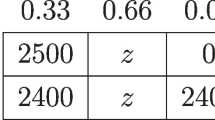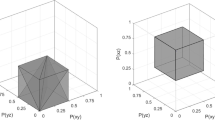Abstract
In this article, we test Green and Jullien's (1988) Ordinal Independence (OI) Axiom, an axiom necessary for any rank-dependent expected utility (RDEU) model, including Cumulative Prospect Theory (Tversky and Kahneman, 1992). We observe systematic violations of OI (some within-subject violation rates of over 50%). These patterns of choice cannot be explained by any RDEU theory alone. We suggest that subjects are employing an editing operation prior to evaluation: if an outcome-probability pair is common to both gambles, it is cancelled when the commonality is transparent; otherwise, it is not cancelled. We interpret the results with respect to both original and cumulative prospect theory and the known empirical properties of the weighting function.
Similar content being viewed by others
References
Camerer, Colin. (1989). “An Experimental Test of Several Generalized Utility Theories,”Journal of Risk and Uncertainty 2, 61–104.
Camerer, Colin. (1992). “Recent Tests of Generalizations of Expected Utility Theory.” In Ward Edwards (ed.),Utility: Theories, Measurement, and Applications. Boston: Kluwer Academic, pp. 207–251.
Camerer, Colin, and Teck-Hua Ho. (1994). “Violations of the Betweenness Axiom and Nonlinearity in Probability,” Journal of Risk and Uncertainty 8, 167–196.
Chew, Soo-Hong and Kenneth R. MacCrimmon (1979). “Alpha-nu Choice Theory: An Axiomatization of Expected Utility,” Faculty of Commerce Working Paper No. 669, University of British Columbia.
Conlisk, John. (1989). “Three Variants on the Allais Example,”American Economic Review 79, 392–407.
Gonzalez, Richard (1993). “Estimating the weighting function,” paper presented at the 26th Annual Mathematical Psychology Meeting.
Gonzalez, Richard and George Wu (1994). “New Directions in Modeling Risky Choice,” paper presented at the 37th TIMS/ORSA meeting, Boston, MA.
Green, Jerry R., and Bruno Jullien. (1988). “Ordinal Independence in Nonlinear Utility Theory,”Journal of Risk and Uncertainty 1, 355–387.
Huber, Joel, John W. Payne, and Christopher Puto. (1982). “Adding Asymmetrically Dominated Alternatives: Violations of Regularity and the Similarity Hypothesis,”Journal of Consumer Research 9, 90–98.
Kahneman, Daniel, and Amos Tversky. (1979). “Prospect Theory: An Analysis of Decision under Risk,”Econometrica 47, 263–291.
Luce, R. Duncan, and Peter C. Fishburn. (1991). “Rank- and Sign-Dependent Linear Utility Models for Finite First-Order Gambles,”Journal of Risk and Uncertainty 4, 29–59.
Machina, Mark (1982). “‘Expected Utility’ Analysis without the Independence Axiom,”Econometrica 50, 277–323.
Machina, Mark J. (1987). “Choice under Uncertainty: Problems Solved and Unsolved,”Journal of Economic Perspectives 1, 121–154.
Pratt, John W. (1964). “Risk Aversion in the Small and in the Large,”Econometrica 32, 122–136.
Prelec, Drazen. (1990). “A ‘Pseudo-endowment’ Effect, and its Implications for Some Recent Nonexpected Utility Models,”Journal of Risk and Uncertainty 3, 247–259.
Prelec, Drazen. (1993). “The Probability Weighting Function,” unpublished paper.
Quiggin, John. (1982). “A Theory of Anticipated Utility,”Journal of Economic Behavior and Organization, 323–343.
Simonson, Itamar and Amos Tversky (1992). “Choice in Context:Tradeoff Contrast and Extremeness Aversion,”Journal of Marketing Research 29, 281–295.
Starmer, Chris and Robert Sugden. (1989). “Violations of the Independence Axiom in Common Ratio Problems: An Experimental Test of Some Competing Hypotheses,”Annals of Operations Research 19, 79–101.
Starmer, Chris, and Robert Sugden. (1993). “Testing for Juxtaposition and Event-Splitting Effects,”Journal of Risk and Uncertainty 6, 235–254.
Tversky, Amos (1969). “The Intransitivity of Preferences,”Psychological Review 76, 31–48.
Tversky, Amos, and Daniel Kahneman (1992). “Advances in Prospect Theory: Cumulative Representation of Uncertainty,”Journal of Risk and Uncertainty 5, 297–323.
Wakker, Peter P., Ido Erev, and Elke U. Weber (1993). “Comonotonic Independence: The Critical Test between Classical and Rank-dependent Utility Theories,” unpublished paper.
Wakker, Peter P., and Amos Tversky. (1993). “An Axiomatization of Cumulative Prospect Theory,”Journal of Risk and Uncertainty 8, 147–176.
Yaari, Menahem E. (1987). “The Dual Theory of Choice Under Risk,”Econometrica 55, 95–117.
Author information
Authors and Affiliations
Rights and permissions
About this article
Cite this article
Wu, G. An empirical test of ordinal independence. J Risk Uncertainty 9, 39–60 (1994). https://doi.org/10.1007/BF01073402
Issue Date:
DOI: https://doi.org/10.1007/BF01073402




